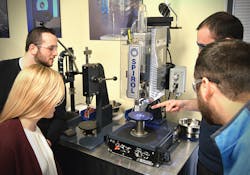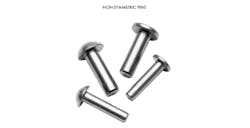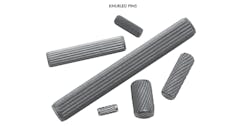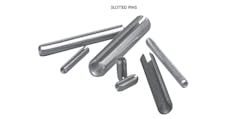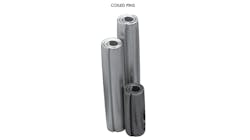Selecting Dowels and Pins for Automated Assembly
Download the PDF of this article.
When a company automates an assembly process, the fastening pins that will be used during assembly are just as important as the automation equipment.
Two of the biggest motivators for companies choosing to use automatic fastening over manual fastening are increasing productivity and reducing costs. Unfortunately, many managers don’t realize the effect fasteners have on achieving these goals. Not all fasteners are easy to orient, feed, or install. Also, the more tooling needed to orient and deliver the fastener, the more expensive the equipment is going to be. It is important to select fasteners that meet the application requirements and are conducive to automation if you really want to see higher productivity and lower costs.
Fastener Issues
The decisions that will determine the success of and simplify automation are made in the design stage of the assembly. One common mistake here is to prioritize the cost of the fasteners over the cost of fastening. Any money saved on fasteners can be quickly gobbled up by intricate automation equipment, lower productivity due to increased assembly cycle times, and equipment downtime. Companies should focus on the lowest installed cost fastener. Typically, these are permanently installed fasteners that get pressed into, rather than threaded into, holes with no secondary operations for retention required.
There are a few general considerations to keep in mind when thinking about automating fastener installation. For example, the length-to-diameter ratio of the fastener is crucial. Any part with a length-to-diameter ratio of less than 1:1 has the potential to tumble and jam in feed tubes. It is also recommended that the fasteners be clean and sorted. Dirty fasteners not only cause some parts to stick in the feeder bowl, but also to get stuck in feed tubes. Unsorted fasteners can jam up insertion equipment. This can be costly when valuable time is wasted breaking down the machine to clear the jam.
Design engineers and assemblers should familiarize themselves with fastener features that affect the success of an automation project. For the sake of this discussion, the features have been broken down into symmetrical and non-symmetrical.
Non-symmetrical Fasteners
Fasteners that aren’t symmetric can be challenging to automate depending on their features. They require end-to-end orientation, so more expensive tooling is needed than that for symmetrical fasteners.
To use traditional automation methods, headed fasteners such as headed pins, as well as screws and bolts, should be able to hang by the head. A good rule of thumb is that there should be a minimum of a 20% difference between diameters of the head and body. This is enough to give mechanical machinery enough of a difference to permit orienting and hanging fasteners. If the difference between diameters can be held to between 20% and 30%, higher tooling costs can be avoided. Headed parts with inconsistent head diameters or shafts tend to get jammed on the feed rail.
Flat-headed fasteners are better than round-headed ones for automation, as it’s easier to press a flat insertion tool onto a flat surface while keeping the fastener straight than a round surface. (The tool, called a quill, pushes the fastener out of installation machine and into the hole in the assembly.) The costs to feed, orient, and install headed fasteners make it critical to ensure the application truly requires a headed fastener before specifying one.
Non-headed, non-symmetrical fasteners must also have some differential if you are going to use the traditional feeding method of hanging them on a set of rails. This can be a 20% difference between body and feature diameter, or a significant weight imbalance of at least 10% between fastener ends. (Basically, when put in a set of rails, the natural tendency of the fastener should be to fall in one particular direction every time.) If this is not the case, a more complex method of orienting needs to be devised. There are several methods to choose from: vision, laser, optical sensor, or a gaging bushing. However, using symmetrical fasteners let companies save significantly on the cost of the automation equipment
Symmetrical Fasteners
Symmetrical fasteners give engineers a continuous profile, which are ideal for automating. They are the easiest to feed because they require little, if any, orientation. Basically, all that’s needed is a machine that delivers parts in a straight line to the feed tube. Once oriented, these parts typically get fed in a tube down to some type of insertion equipment. Some examples of symmetric fasteners include straight (dowel) pins, grooved pins, knurled pins, and slotted and coiled spring pins.
However, there are a few disadvantages to symmetric fasteners. For example, straight dowel pins are highly dependent on the host material (the material it is inserted into) for retention. This means the cost of hole preparation can be expensive, since it requires reaming to get the required tight tolerances. (The exception is when these pins are used in plastic, because the holes are molded and plastic is forgiving.)
To compensate for some of straight solid dowel pins’ disadvantages, engineers developed grooved and knurled pins. The diameter across the grooves and knurls is designed to be larger than the hole. When a hardened grooved pin is used for strength, the host material deforms—though not to the same extent as when a straight solid pin is used. And knurled pins cut their way into host components. However, neither the knurled nor grooved pins require the tight tolerances needed by straight solid pins. Regardless, insertion forces are usually much higher for all solid pins, which can dramatically raise the cost of the automation equipment. In addition, solid pins must deform the host material for retention, so there is the possibility for cracked or damaged components during installation.
Spring Pins
To compensate for solid pins’ disadvantages, designers developed the spring pin. When a spring pin is driven into a hole, the pin’s spring action lets it compress as it assumes the diameter of the hole. Once installed, radial forces exerted by the pin against the wall of the hole provide self-retention. Properly selected spring pins do not deform the material for retention, so there is no damage to the host component and installation forces are lower. In addition, spring pins can compensate for hole tolerances and minor hole mismatches.
There are two types of spring pins: slotted and coiled.
Slotted pins come with a gap that lets them flex. Due to the manufacturing process, these pins do not have even chamfers or square ends. Slotted pins are a great way to reduce costs for manual installation, however when automating, it is highly recommended to avoid these pins. The biggest problem when automating slotted-pin installation involves the non-square ends. When a slotted pin enters the escapement in the installation machine, its uneven end tends to catch on the pin above it in the feed tube and prevent pin advancement. The gap can also cause slotted pins to get interlocked and jam the pin inserter.
The manufacturing method of roll forming used to make slotted pins can also result in a bowed or banana-shaped part. That’s because pins tend to stretch at the slot and contract 180 deg. from the slot. The stresses imparted to the pins in the heat treating/quenching process also tend to distort slotted pins. If the pin is not straight, it will not pass through the discharge bushing in the feed bowl, and therefore never make it into the feed tube. Finally, to maximize strength, slotted pins must be oriented so that the applied force passes directly through the gap. This can be tricky to automate, and expensive.
Coiled Spring Pins
To compensate for disadvantages of both solid and slotted pin, engineers developed coiled spring pins. These pins are manufactured from strip material rolled into a spiral spring of 1.5 or 2.25 coils. They have several features that contribute to trouble-free automation. Coiled pins never nest or interlock because they have no slots. In addition to the spring nature of the pin, the square, clean-cut ends, combined with a smooth, concentric lead-in chamfer and a blended radius, eliminate sharp edges and angles that may “bite” into the hole wall, thus lowering insertion forces. The chamfer concentricity assists in aligning with the host and mating holes. Plus, this pin does not have to be oriented for strength. These attributes can significantly reduce downtime during assembly, decrease equipment costs, and result in trouble free assembly.
The duty (or material thickness) of coiled pins can be varied to provide the best combination of strength and flexibility. The lighter duty pins require less insertion force, thus reducing the cost of the automation equipment because a smaller cylinder and/or machine can be used. In applications where this pin is appropriate, the ease of automation makes this the lowest installed cost fastener.
Keep in mind that just about anything can be automated, if there is enough time and money. But by considering fasteners during the design stage, companies can achieve automatic fastener installation at the lowest installed cost.

